Ogden and Lyon Almost Obliterated
Park East Freeway would have run to lakefront, eliminating both streets.
In the mid-1830s many tens of thousands of acres of Wisconsin land were sold to speculators. Some of these buyers were men whose names would appear on Milwaukee street signs. The list includes the city’s founders, Solomon Juneau, Morgan L. Martin, Byron Kilbourn, and George Walker, as well as Daniel Wells, Garrett Vliet, William B. Ogden, and Lucius Lyon, among others.
The biography of Morgan L. Martin, Solomon Juneau’s partner, reports that Ogden and Lyon purchased land near Martin’s Juneautown. The two were among the investors in the New York-Wisconsin Land Company, which speculated in the development of Manitowoc, Kewaunee, and Milwaukee. Ogden and Lyon Streets were platted just north of Juneautown in 1837.
At the time, William Butler Ogden was serving as Chicago’s first mayor. He was born into a real estate family in 1805 in Walton, New York. As a young man, Ogden took over the business after his father’s death and moved to the Windy City. He speculated in land throughout the country but most of his holdings were in Wisconsin. Streets were named for him in Fond du Lac, Milwaukee, Chicago, the Bronx, and Escanaba, Michigan.
Ogden was the first president of the Union Pacific Railroad, which linked with the Central Pacific Railroad in 1869 to provide the country with its first transcontinental railroad. The city of Ogden, Utah, near where the link occurred, is also named for him.
The Great Chicago Fire of 1871 wiped out much of Ogden’s wealth. On the same day, the Peshtigo fire in Wisconsin destroyed his lumbering operations. After the fires he left Chicago for New York City, where he died six years later.
Lucius Lyon was born in Vermont in 1800 but spent most of his adult life in Michigan. He surveyed throughout Michigan and Wisconsin and he kept his eyes open for desirable land. When Lyon Street was named for him he was serving Michigan as U.S. Senator, and later he was elected to the U.S. House of Representatives. Lyon died in Detroit in 1851.
Despite being only one block apart, the streets developed differently. They both ran east from N. Water Street for a little over half a mile. E. Lyon Street was quiet, narrow, and overwhelmingly residential. E. Ogden Street was wider, busier, and part of a streetcar route from N. Jackson Street east to N. Farwell Avenue. It was lined with grocery stores, restaurants, and other businesses as well as apartment buildings. To reflect its importance as a thoroughfare, the Common Council upgraded Ogden Street to Ogden Avenue in 1888.
In the 1960s, despite their differences, the streets shared the same fate. Although it seems very bizarre to us today, there was a plan to build a freeway along the lake bluff. It was to be connected to I-43 via a corridor that, on the east side of the river, was between Ogden and Lyon. Almost all the buildings in the corridor were demolished in preparation. Concerned Milwaukeeans were alarmed that the beautiful asset that is the lakefront would be divided by the freeway, including an interchange at the end of E. Ogden Avenue at the lake bluffs. They fought against the plan.
While that battle raged, the Park Freeway construction continued. Extending eastward from I-43, what became known as the Park East Freeway reached N. Jackson Street in 1971. Fortunately, there it ended. Opponents of the Lake Freeway were successful. The corridor to the east of N. Jackson Street remained a waste land for more than 20 years, except for a community garden on part of it. In the early 1990s, led by developer Barry Mandel, it was redeveloped with apartments and condos.
In the early 2000s, the Park Freeway itself was demolished, freeing up land between N. Water and N. Jackson Streets for development, including Ogden Ave. and Lyon Street. There is still some open land available but no matter how it is used, the result will still be that E. Ogden Avenue and E. Lyon Street will be more alike than they were in the past. Though E. Ogden Avenue will again be on a streetcar route, unlike earlier streetcars that traveled along a business street, the new streetcars will pass down a residential avenue.
Carl Baehr, a Milwaukee native, is the author of Milwaukee Streets: the Stories Behind their Names, and articles on local history topics. He has done extensive research on the sinking of the steamship Lady Elgin, the Newhall House Fire, and the Third Ward Fire for his upcoming book, “Dreams and Disasters: A History of the Irish in Milwaukee.” Baehr, a professional genealogist and historical researcher, gives talks on these subjects and on researching Catholic sacramental records. He earned an MLIS from the UW-Milwaukee School of Information Studies.
Sites Along Ogden and Lyon
If you think stories like this are important, become a member of Urban Milwaukee and help support real, independent journalism. Plus you get some cool added benefits.
City Streets
-
The Curious History of Cathedral Square
 Sep 7th, 2021 by Carl Baehr
Sep 7th, 2021 by Carl Baehr
-
Gordon Place is Rich with Milwaukee History
 May 25th, 2021 by Carl Baehr
May 25th, 2021 by Carl Baehr
-
11 Short Streets With Curious Names
 Nov 17th, 2020 by Carl Baehr
Nov 17th, 2020 by Carl Baehr


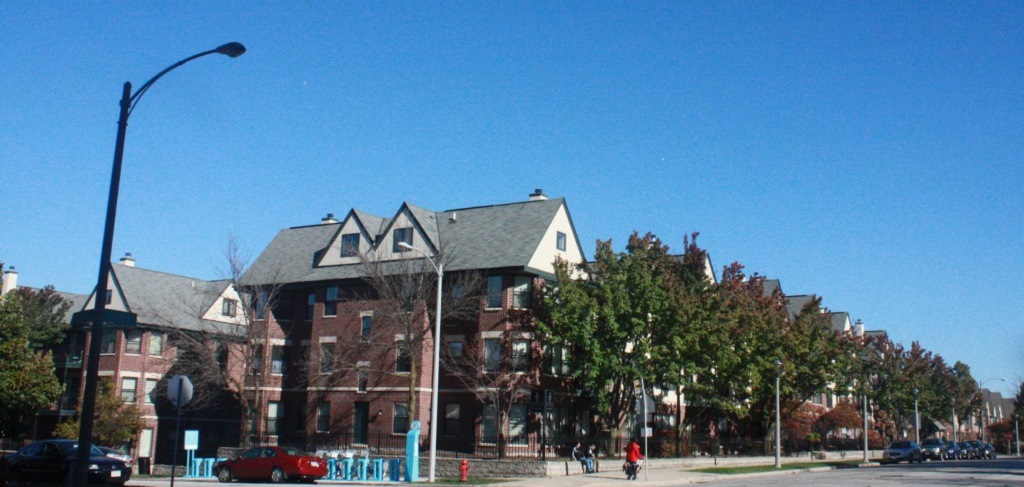
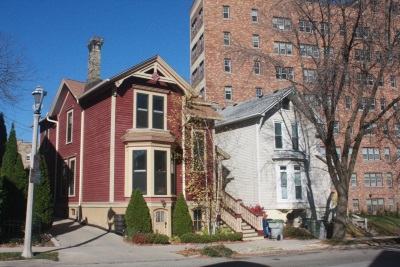
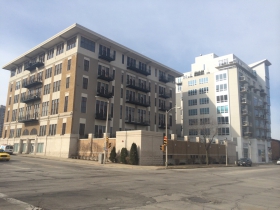
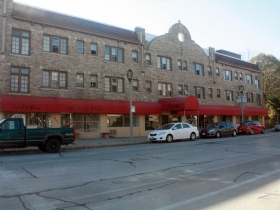
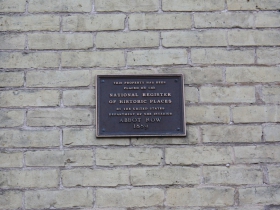
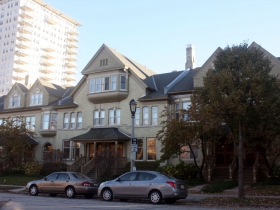
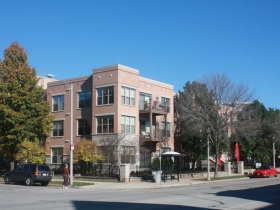
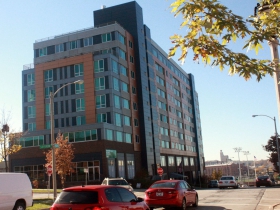















This is a very interesting tidbit of history, hopefully, we’ll see something about the ill-fated Park West Freeway & what’s becoming of the many blocks demolished for that as well.
Cheers to history and let’s not repeat its follies.
At least one source of Milwaukee freeway history indicates that construction never started on the lakefront interchange proposed down the bluff from Ogden. That does not hold up. Much controversy surrounded that project and it went to a judge to decide if it should be built. An effort was begun to start the project, perhaps concurrent with the trial, so the interested parties could say construction was proceeding. Today two concrete columns, with reinforcing steel bits sticking up still stand on the bluff. At this time of year, with most of the leaves gone, these are visible from the bike path. They stand half-way up the bluff a few yards north of the Ogden Street stairway. I guess the judge said, “no freeway.” So that’s something that saved much of our lakefront.
It would be nice if Mandel were able to leave these bits of history when they develop the property above the bluff.
(At the time there was an article in the Milwaukee Journal which was written in the 60s about the trial and its outcome but I have not yet found it.)
I’ve heard that Ogden Ave was in many ways similar to the dynamic mix of businesses that line Brady Street today. What a shame that Milwaukee lost such a vibrant urban corridor… I’d love to see photos of what was once there.
Thanks for the excellent summary. We lived through this history, and are grateful for how it turned out. We lived in Shorewood during the period recounted, but more recently have had four home addresses (2 rented, 2 owned) in the redeveloped area, attended church nearby, and worked over several decades very nearby.
It’s now a vibrant and friendly neighborhood with great convenience aspects for restaurants, groceries, UPS, post office, hardware stores (sorry to be losing National Ace), banking, specialty shops, schools (including MSOE) and all the entertainment venues close by.
We wonder what will happen with the streetcar, especially re: the traffic and congestion midday. There are a couple of hundred (plus?) condo parking garage spaces with limited visibility entering Ogden, plus all the traffic related to Panera, Karma, Chipolte, Pick’n Save, and a dozen other businesses related to East Pointe. It’s overload during parts of the day, sometimes hazardous from a auto traffic visibility standpoint due street-parking-caused blind spots for cars entering Ogden. Have seen accidents and barely avoided two myself. Hard to imagine what it will be like with a streetcar using three (Ogden, Van Buren, Jackson) streets as well as it makes two turns on its route right through that mess.
J, That’s fascinating about the concrete freeway columns. It would be great to preserve them as relics–with the cautionary tale interpreted as a historic marker.
Charlie Kamps was was one of attorneys who fought the lakefront freeway. They based the opposition in part on the Public Trust Doctrine. Someone could interview him about that history. He also founded Preserve Our Parks.
Interestingly, the Wisconsin PTD was also the basis for how the RiverWalk was implemented, since it mandates that access to waterways must be preserved for the public. Legal constructs have greater meaning when connected to specific outcomes. Of course, citizens had to fight to defend those rights. And that can be costly and daunting.
I hope the city will think twice about destroying more of our irreplaceable urban fabric…
Those concrete columns at the base of the bluff below Ogden Avenue are NOT from any Park East Freeway construction.
They are support columns for a section of the Layton School of Art that was never completed. See Bobby Tanzilo’s article in Onmilwaukee.com from April 2, 2014. There is even a picture of the school from the 1950’s in which you can clearly see the columns.
Great article…I’ve been an Yankee Hill/Lower East Side resident since 2007 and I love learning more about the history of this area of Milwaukee. In particular, I’m trying to research the changes that occurred around Ogden Ave. There are some great photos to be found on MPL’s online photo archives.